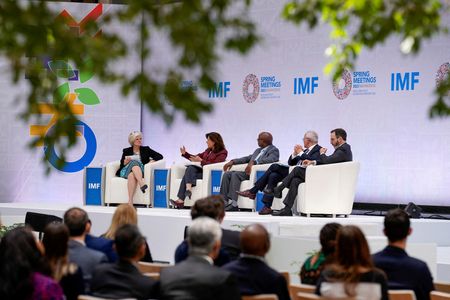By Jamie McGeever
(Reuters) – A look at the day ahead in Asian markets from Jamie McGeever.
Asian markets on Thursday look set to take their cue from the ‘risk off’ U.S. session the day before, with investors hunkering down after minutes of the Fed’s last policy meeting showed officials now expect a “mild recession” this year and are increasingly worried about regional banks.
The Asian/Pacific calendar is pretty light on Thursday, with Chinese trade and Australian unemployment figures for March the main events.
GRAPHIC: China-US trade, https://fingfx.thomsonreuters.com/gfx/mkt/zgvobjalrpd/ChinaUSTrade.jpg
GRAPHIC: Australian unemployment and interest rates, https://fingfx.thomsonreuters.com/gfx/mkt/akpeqneympr/AussieUR.jpg
Day four of the World Bank/IMF spring meetings in Washington could also yield market-moving headlines and China’s president Xi Jinping, having just bade au revoir to French President Emmanuel Macron, welcomes Brazil’s President Luiz Inacio Lula da Silva.
Wall Street, bond yields and the dollar all ended lower on Wednesday, marking a sharp turnaround from earlier in the day when below-consensus U.S. inflation data boosted hopes that the elusive ‘soft landing’ might be within reach after all.
Although core CPI inflation remains sticky and the annual rate is now higher than headline, the year-on-year rate of inflation fell by a full percentage point to 5.0%. There have been only six steeper declines in the past 70 years.
Music to investors’ – and Fed officials’ – ears, but the feelgood factor was snuffed out by the Fed minutes.
Fed officials are right to be worried about credit conditions. The relationship between thousands of small banks and millions of small businesses is critical to the U.S. economy. If one half of the relationship is in trouble, so is the other.
But it’s worth remembering that the meeting was March 21 to 22, right in the white heat of the crisis triggered by the collapse of Silicon Valley Bank and Signature Bank only days before. Recent public remarks from Fed officials suggest they are less worried now.
That’s the broader global tone. Locally, investors are eyeing China’s trade report for March, which is expected to show a collapse in the trade surplus to a two-year low of $39.2 billion.
China’s economic re-opening from the COVID-19 lockdowns continues to divide opinion. Citi’s Chinese economic surprises index is its highest since 2006 and new bank lending hit an all-time high in the first quarter.
But the central bank has had to cut reserve requirements to spur lending, extremely low inflation points to weak demand in the economy, and Beijing’s closeness to Russia and hawkishness on Taiwan continues to unnerve global investors.
Here are three key developments that could provide more direction to markets on Thursday:
– IMF/World Bank spring meetings in Washington
– China trade (March)
– Australia unemployment (March)
(By Jamie McGeever; Editing by Josie Kao)

